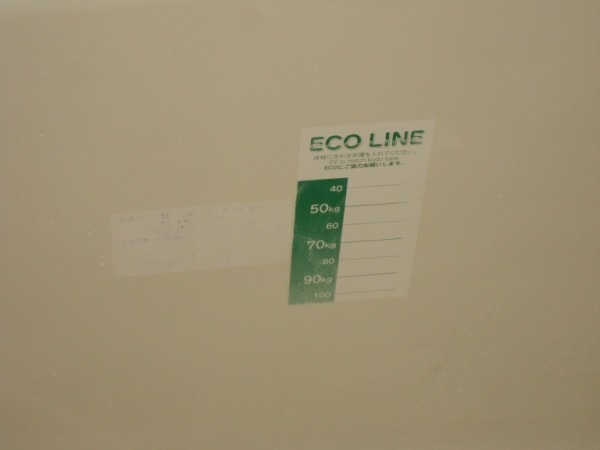It had become clear that we were adjusting for jetlag backwards: we were mostly awake between 12:30 and 7am, talking, showering, soaking beat-up feet and applying Tiger Balm, watching TV, etc, with a nap somewhere in there. Turning on Japanese TV for the first time was pretty entertaining. Too bad they didn’t play any prime-time shows at 5am.
Breakfast was at Cafe du Monde, a chain supposedly from New Orleans. The one thing surprising and annoying about Japan was the smoking at public places, including most dining establishments. During the course of our brief sandwich-and-coffee breakfast, 5 people had come, seated right near us, and smoked. Our risk for lung cancer had just gone up a notch!
Then we experienced for the first time the notoriously crowded morning commuter train. This was Kyoto, not Shinjuku, so it probably wasn’t the real deal just yet. But the level of packed-ness was already beyond where New York subway riders would shout, “Fuck you, wait for the next train!” It was so jammed that if you lift a foot up 3 inches and put it down, you’re likely to step on someone else’s foot. My baby fell victim to that. My theory is that since Asians tend to be more uniform in shape and size, it’s possible to jam together like sardines. Americans would have a much harder time maximizing space efficiency, and it wouldn’t be fair to squeeze a 120-lb person into a 300-lb person’s belly fat.
The train took us to Arashiyama, the mountain region west of Kyoto that was more beautiful than I expected. We walked through the bamboo groove, took a less touristy path through the Turtle Mountain park and down stream along the Hozu River, and over the Togetsukyo Bridge. Skipping the World Heritage site Tenryuji (another Buddhist temple), we went straight to the Monkey Park.
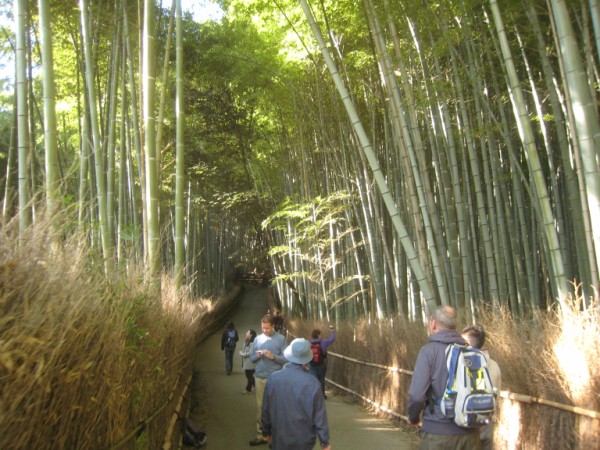
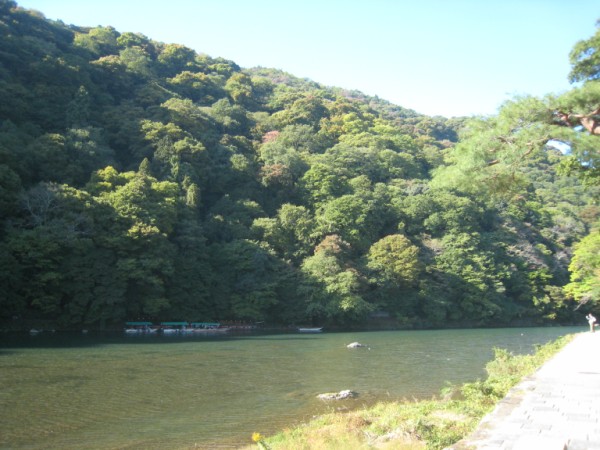
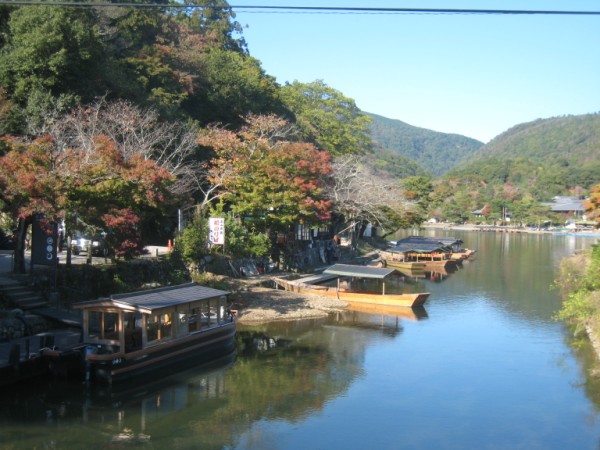
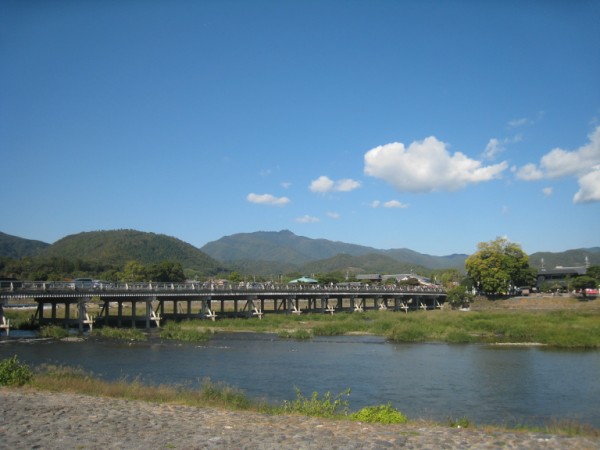
None of the Kyoto tourism websites bothered to mention the level of physical demand at this “zoo”. After paying the entrance fee at the single-person booth, it was a good 30-minute hike up the steep mountain before we saw any ape creature other than the two of us. It was brutal on our already destroyed feet! But then the park was unlike anything we had seen before… a large gang of wild monkeys freely roamed the mountain centering on a small hut, where visitors could buy snacks to feed the monkeys through the wire fence. I know Chee Seng would approve feeding monkeys as much as we’d approve keeping a pet spider, but it was irresistible. It was scary at first to hand-feed wild animals, but their hairy clawed fingers were surprisingly gentle. We tried to favor the babies, but nobody could win a fight over peanuts against the big ones. It was hilarious to watch them hitting each other on the head and stealing food from each other’s mouth. They were also too smart to fall for our distraction tactics. The experience of seeing monkeys on stairs, benches, and binoculars was definitely worth a few more days of swollen feet. Where else can you pee in a urinal while a monkey climbs across the window in front of your eyes and two others bounce on the roof over your head?
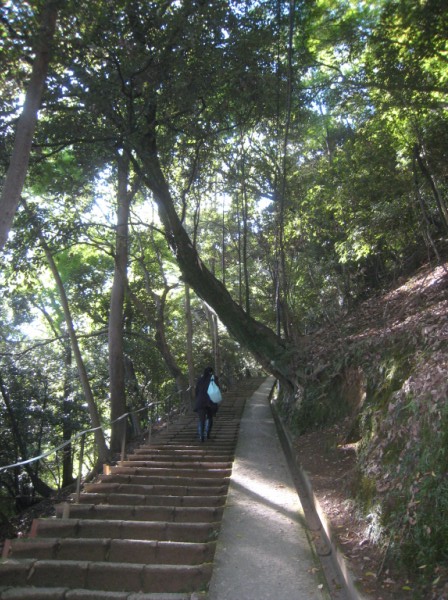
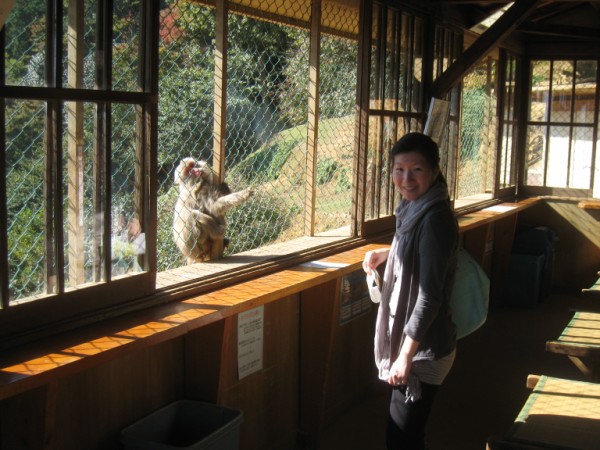
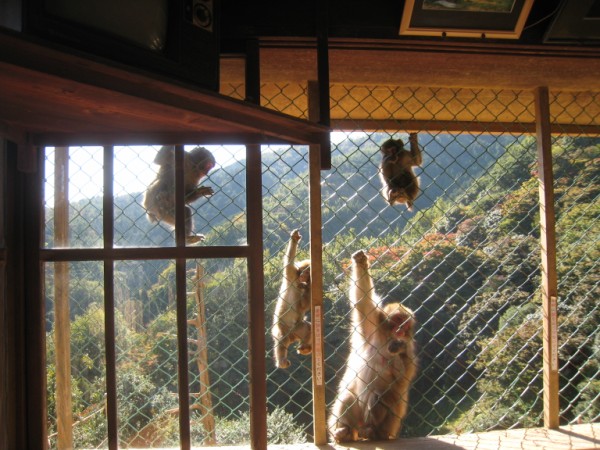
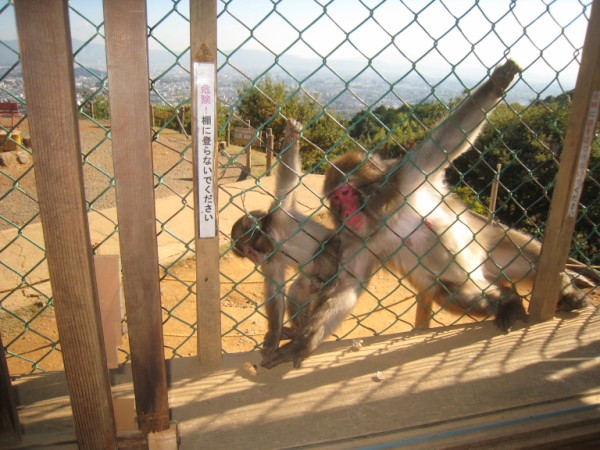
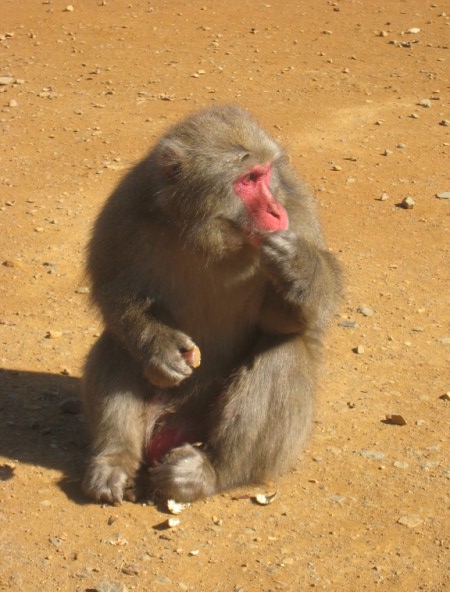
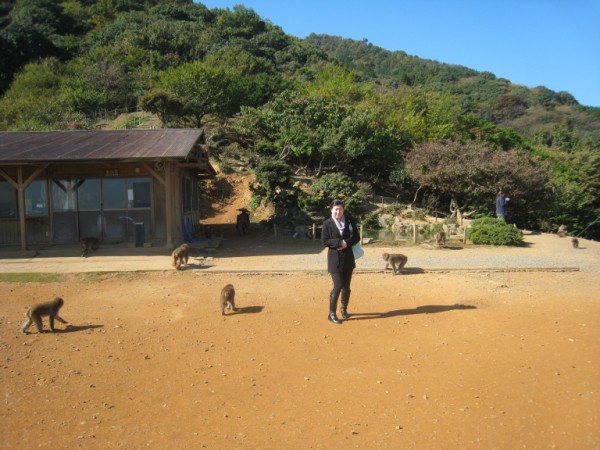
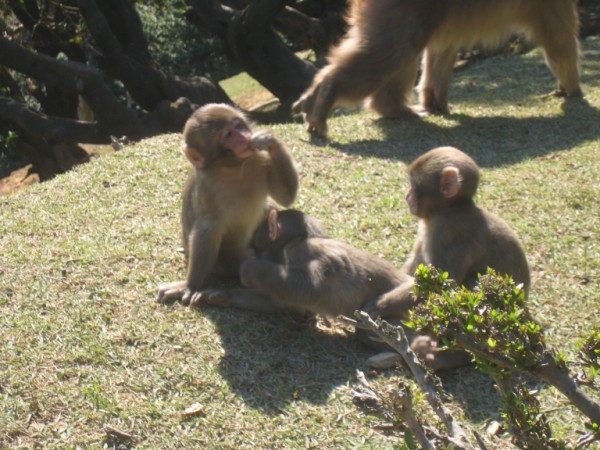
(hmm… what are these three doing there?)
Returning to Kyoto, we hit up Nijo-jo, a rare castle palace with both defensive elements like walls, towers, and moats, and luxury elements like palace buildings, paintings, and gardens. The one thing that every tourism website mentioned about Nijo-jo was the security feature: the floor in the palace hallways would make a sound of nightingale when stepped on, in order to warn of potential intruders. I was highly intrigued because it reminded me of the training scenes in Ninja Assassin. To my surprise, we were actually allowed to walk on such floors – but it wasn’t always easy to tell apart the nightingale sound by design and the creaking sound of the aged wood.
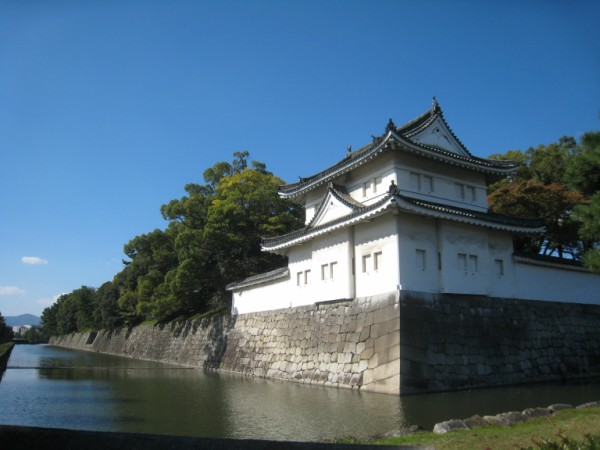


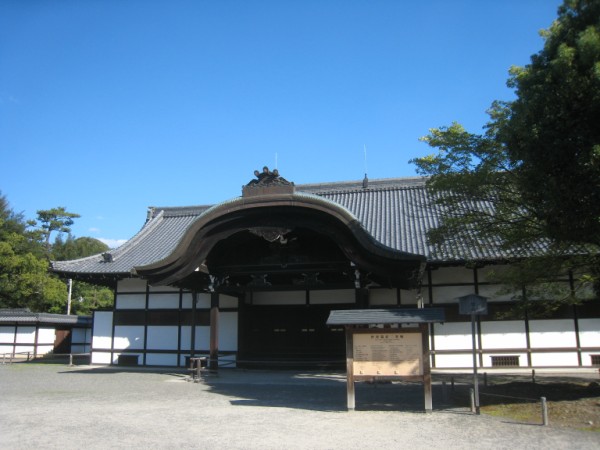
The remainder of the day was spent in the Kawaramachi/Teramachi district, where the covered shopping arcades, a huge department store, restaurants, and food carts kept us occupied. We checked out the Benkei Stone, which was briefly mentioned in a Detective Conan movie. Because our feet started hurting like hell again, we made frequent food stops in order to sit down and rest. Of particular noteworthiness was the Crepe Ojisan cart and then conveyor belt sushi place where I tried smoked horse meat (nasty).
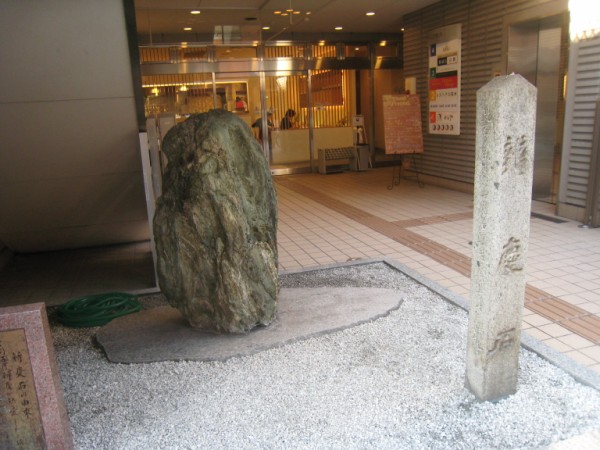
Benkei Ishi (stone)

Uncooked squid
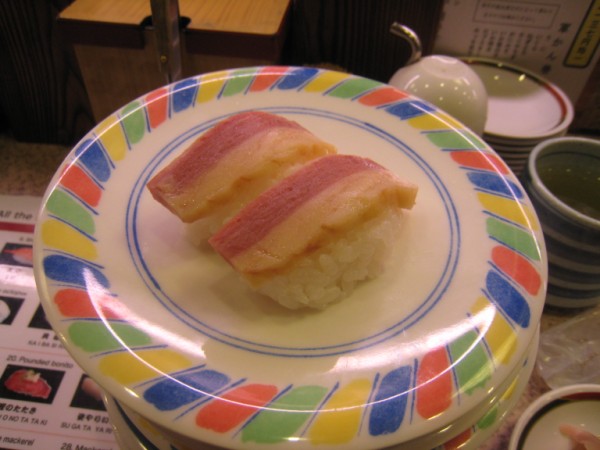
Smoked horse sushi. The meat-like stuff and the rice didn’t stick together at all.
Those of you who have traveled in Asia would know how hotels here provide necessities that American hotels don’t: tooth brushes, tooth paste, combs, razors, shaving cream, slipper, etc. Ours went the extra mile to drop us off a daily package of the aforementioned, new tea/coffee bags, sheets, and towels, even though we put up the “do not disturb” sign to avoid unnecessary cleaning efforts. That’s the Japanese customer service showing off again.
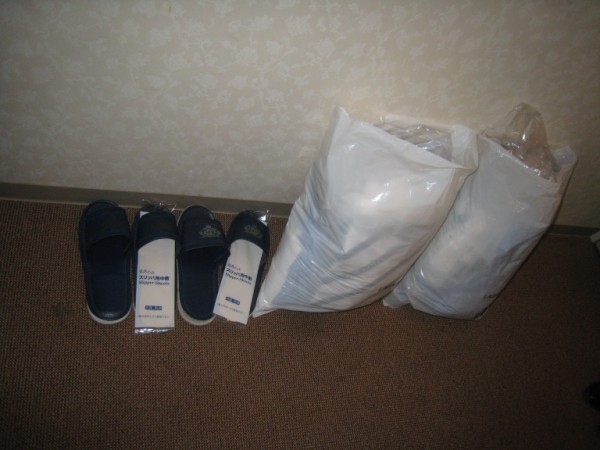
On the side of our bath tub was a bath meter indicating how much water to fill up given a patron’s weight. Slightly unintuitive at first, it did make sense that a heavier person’s body would displace more volume, assuming similar human body density, and raising the water level higher upon entering a tub of the same base area. I tested this out with water filled to the 70kg mark, and the amount was quite perfect. While enjoying water hot enough to cook ramen (no way in hell would an American hotel provide this due to liability concerns), I wondered how much water a 300lb person should fill since it was off this chart. Then I realized that the person in question wouldn’t have been able to even enter this room in the first place.
